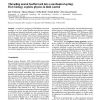Free Online Productivity Tools
i2Speak
i2Symbol
i2OCR
iTex2Img
iWeb2Print
iWeb2Shot
i2Type
iPdf2Split
iPdf2Merge
i2Bopomofo
i2Arabic
i2Style
i2Image
i2PDF
iLatex2Rtf
Sci2ools
BC
2005
2005
Threading neural feedforward into a mechanical spring: How biology exploits physics in limb control
A solution is proposed of the hitherto unsolved problem as to how neural feedforward through inverse modelling and negative feedback realised by a mechanical spring can be combined to achieve a highly effective control of limb movement. The revised spring approach that we suggest does not require forward modelling and produces simulated data which are as close as possible to experimental human data. Control models based on peripheral sensing with forward modelling, which are favoured in the current literature, fail to create such data. Our approach suggests that current views on motor control and learning should be revisited.
| Added | 15 Dec 2010 |
| Updated | 15 Dec 2010 |
| Type | Journal |
| Year | 2005 |
| Where | BC |
| Authors | Karl-Theodor Kalveram, Thomas Schinauer, Steffen Beirle, Stefanie Richter, Petra Jansen-Osmann |
Comments (0)

